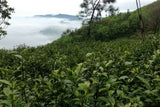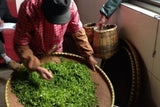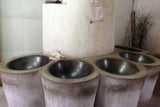Mrs Wang's Mogan Mountain - yellow tea
Sold Out

| Style | Yellow Tea | |
| Origin | Moganshan, Hu Zhou, Zhejiang Province, China | |
| Season | April Harvest | |
| Altitude | 785m | |
| Batch | SCY1 | |
| Plant | Jiu Keng | |
| Tea Master | Master Wang |
Yellow tea is the rarest of the six classes, produced in small quantities exclusively in China. Few tea masters with the skill needed to make this tea are still alive. This tea is a special treasure to savour and appreciate.
Mrs Wang was taught to craft this tea by her mother and only makes it on our special request. Expect a light sweetness, zero astringency and a touch of apricot. No chemical fertiliser, pesticide, or herbicide was used in the production of this tea.

The Stories We Drink
|
Yellow tea is the rarest type of tea in the world and is difficult to access outside China. There are only four varieties of this tea and just a handful of tea masters with the skills and knowledge to produce them. It is often confused for green tea, but has a mellower, sweeter and more refereshing flavour with less bitterness. This yellow tea is exceptionally rare because it’s produced by one of the only female yellow tea masters in the world. The majority of tea masters in China are male. Mrs Wang who makes this tea was taught by her mother when she became too old to continue. Her two sisters also have the skills to make the tea and now Mrs Wang’s own daughter is also learning the craft. This Mogan yellow tea is grown and cultivated on Mo Gan Shan, the highest mountain in De Qing Country in Zhejiang province. The mountain has perfect growing conditions, with an altitude of 758 meters, an average temperature of 15 degrees, lots of low cloud cover and humidity sitting at around 80%. The mountain has a network of pristine spring water and only natural fertilisers are used in the area. The plants have deep, strong root systems and the majority of tea from this mountain is ultimately processed into green tea. Yellow tea was first produced during the Tang Dynasty in 618 and became revered during the Qing Dynasty (1644 – 1911) but by 1940 black and oolong teas were becoming more popular. Given these types of teas were much less labour intensive to produce, yellow tea production reduced dramatically and, even today, it is exceedingly rare to find exceptional quality yellow tea. |
|
Craftsmanship
Yellow tea production is increasingly rare and China faces a challenge in maintaining this cultural knowledge and craftsmanship into the future. Mrs Wang is confident her daughter will develop the necessary skills to make this tea when she is no longer able to, and that is important to her, and to her daughter.




















